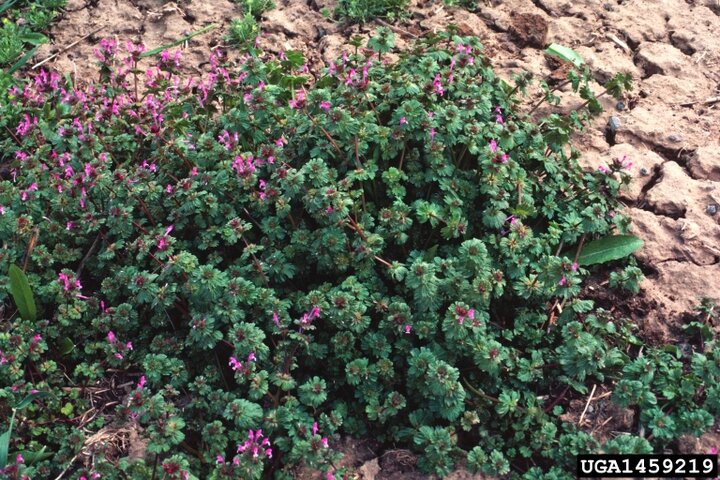Sarah Browning, Extension Educator

Ground Ivy flowers - Pixabay
It’s amazing to gardeners that our lawns and landscapes can just be greening up in spring and yet there are weeds already growing like gangbusters and blooming! How do they get started so quickly? Aside from dandelions, three of the most common culprits found in the spring landscape are creeping Charlie, henbit and field speedwell.

Henbit, Lamium amplexicaule, a member of the mint family, is a winter annual. That means it germinates from seed in fall and grows into a very small plant, which overwinters through December and January. It begins growing again very early in late winter and is often flowering by early March through May.
Henbit has a similar look and is often confused with creeping Charlie. It has square stems and a minty odor when damage, but look for these differences to tell the two weeds apart. Henbit leaves on the upper portion of the stems are clasping, meaning they are directly attached to the underlying stems without any secondary petiole, and wrap around the stems. Leaves on the lower stem portions closer to the ground may have a short petiole. Leaves are more sharply toothed than the scalloped leaves of creeping Charlie and the flowers are tubular and bright pinkish-purple. Plant height ranges from 3-15 inches.

Speedwell, Veronica spp., is another common early spring weed, which often acts as a winter annual weed. Plants grow as a flat cluster of stems on the ground. Its tiny leaves, about ¾ inch wide at most, are arranged opposite each other on slim stems. The leaves, although much smaller than ground ivy, have similar rounded scallops on the edges. Their flowers are blue, often with a white throat if you look closely. Plants bloom from April through August.
Coming soon, Creeping Charlie, Glechoma hederacea, also known as ground ivy, is a low-growing perennial weed which creeps through lawns and landscape beds. Even in a very dense stand of zoysia grass, creeping Charlie will withstand the grass’s competition and gradually spread via both above ground stems (stolons) which root at each node, and below ground stems (rhizomes).
As a member of the mint family, it has square stems and a minty odor when damaged. Leaves develop opposite each other along the stems and are attached to the main stem via short secondary stems (petioles). They are small, approximately ½-1 inch across, with rounded scalloped edges. Small tubular flowers are light blue to bluish-purple, produced from April through June.
Control
So what should a gardener do if these weeds are a continual problem each year? First, realize spring is not the best time of year for control.
Winter annual weeds germinate in the fall, overwinter as a small rosette of foliage, and begin growing again in early spring. They complete their life cycle and go to seed in spring or early summer. Gardeners usually want to control these weeds in spring when they are blooming, but that’s not the best strategy. Since winter annuals are blooming by the time gardeners notice them, they usually will or have already produced seed by the time they are killed by herbicides.
A better strategy for controlling winter annuals is to target them in fall. Mulch and an application of pre-emergent herbicide in September is the best method of control. Or kill them right after they germinate by hoeing or target young plants by spot-spray applications of post emergent herbicides, such as those containing 2,4-D, quinclorac or triclopyr.
Perennial weeds like creeping Charlie are also best controlled in fall, when perennial weeds begin moving carbohydrates from the leaves down to the roots for winter storage. Fall applied herbicides are transported to the roots along with the carbohydrates killing the entire plant instead of just the leaves. And even if the chemical doesn't completely kill the weed, the plant goes into winter in a weakened condition and is much more susceptible to winter kill. Three-way products like Trimec or those containing 2,4-D, quinclorac or triclopyr also work well against perennial weeds.
If post emergent herbicide control is needed, use spot treatments or spraying individual weeds, which saves money on chemicals. Broadcast applications are a waste of money if only a few weeds are present.
Bottom-line? Ignore the weeds in your lawn and landscape now, or hand-pull them if removal is essential right now. Plan for fall control in lawn and landscape areas with a history of problems and you’ll have much better success at long-term control.
Before applying any herbicide, always identify the weeds you are trying to control. Get help from your local garden center or Nebraska Extension office if you’re not sure to avoid making applications at the wrong time of year and wasting your time and money on an ineffective application.
Search Our Archive
Associated Video
Turf Weeds
UNL Extension Turfgrass Specialist Zac Reicher talks about controlling common turf weeds. May 17, 2013